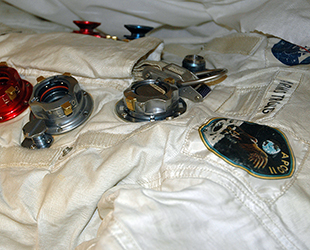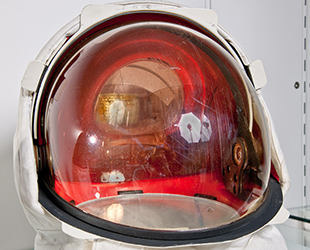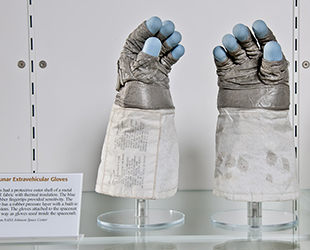September 6, 2012 — The gloves and visor that the late Neil Armstrong wore during his historic moonwalk are now on display for the first time in more than a decade.
On Tuesday (Sept. 4), the Smithsonian's National Air and Space Museum retrieved Armstrong's spacesuit artifacts from its preservation facility and placed them on exhibit at the Steven F. Udvar-Hazy Center in northern Virginia. The visor and gloves will be on display for two weeks while the country continues to mourn the Aug. 25 death of the first man to step foot on the moon.
"With the unfortunate, untimely death of Neil Armstrong, we thought we had to do something and there really is no benefit in preserving something if the public cannot see it forever," explained Cathleen Lewis, spacesuits curator at the National Air and Space Museum in Washington, D.C.
"We considered what we could do and the EV gloves and the EV visor were the most capable of being taken out of storage and put on display for a brief period of time with the minimal amount of damage," she told collectSPACE.
Conserving the crown jewels
Armstrong's Apollo 11 spacesuit, including his gloves and visor assembly, had been on public display at the National Air and Space Museum's flagship building in Washington, D.C. until 2001. Although it survived the historic journey from the Earth to the moon and back in 1969, the suit and its components were not faring as well with the passage of time.

Close-up of astronaut Neil Armstrong's Apollo spacesuit, as seen in storage at the Smithsonian in March 2008. (collectSPACE) |
"We took them off display for conservation reasons," said Lewis. "The suit is deteriorating because of the breakdown of its materials. We decided because it is really one of the crown jewels of the collection that we wanted to protect it as much as possible."
"It has been in storage since then," she said.
The Smithsonian's conservators determined that the best solution for Armstrong's spacesuit and the others like it was to keep it at about 60 degrees Fahrenheit and at less than 30 percent humidity. A special vault was designed to maintain the suits, each in their own custom fitted trays.
Curators also periodically rotated the spacesuits remaining on display to give them a chance to "rest." Currently, the spacesuit that Armstrong's crewmate Buzz Aldrin wore on the moon is at the museum's National Mall building.
Scratches and repairs
Despite their careful handling, Armstrong's visor assembly and gloves did not escape damage. As a result, one of the artifact's most famous features, the gold-coated visor, can no longer be viewed today.

A7-L Lunar Extravehicular Visor Assembly (LEVA) worn by Neil Armstrong, as seen on temporary display at the Steven F. Udvar- Hazy Center in Chantilly, Virginia. (Smithsonian/Dane Penland) |
"The visor has been scratched over the years from use," Lewis told collectSPACE. "In some part, it's a design flaw. Over time, with the gold shield being raised and lowered and the louvers on the sides being moved back and forth, the gold has been scratched in many places."
"It has been the decision of our conservator that the visor will never be lowered again," Lewis said. "We are trying to find a way to preserve that for as long as possible, so we did not move that visor down, even for this display."
Guests visiting the Udvar-Hazy Center will be able to see however, the damage to Armstrong's right glove — and its unexplained repair.
"That is one of those mysteries that I hope one day to be able to solve," Lewis shared, referring to small gray marks on the wrist of the gauntlet. "We know that the astronauts had a repair kit in the lunar module to repair punctures on the cover layer [of the spacesuit]. What we don't know is whether those repairs were made prior to the flight, during the flight or sometime after the flight when the suit was in NASA's possession."
"I have not been able to find any record of it," Lewis said, "and unfortunately, it is too late to ask Mr. Armstrong."
Last look until...
Armstrong's visor assembly and gloves, which are two of the most iconic parts of his spacesuit, are displayed in the Udvar-Hazy Center's Space Hangar, the same hall where the space shuttle Discovery went on display in April.

Extra-Vehicular (EV) gloves made for and worn by astronaut Neil Armstrong during Apollo 11 in 1969. (Smithsonian/Dane Penland) |
The first moonwalker's artifacts were placed into a secure glass case opposite the mobile quarantine facility that was used to sequester Armstrong, Aldrin and Michael Collins after they returned from the moon. Nearby to the case are also the inflatable balloons that helped keep the Apollo 11 spacecraft upright and afloat after it splashed down in the ocean.
The gloves and visor will remain available for the public to view for about two weeks. A specific date when the exhibit will end has not yet been set, but Lewis said it will stay at least until after the public memorial service for Armstrong, which NASA has set for Sept. 13 at Washington National Cathedral.
After this brief display ends, the next time the gloves and visor, together with the Armstrong's spacesuit, may go on display is in 2017 when the museum plans to open a new gallery devoted to the programs that led to men walking on the moon.
"What the events of the last two weeks [since Armstrong's death] have really driven home is the imperative of getting these objects out for the public to see so they understand what they meant in 1969 to him, the American public and to the world," Lewis said.
